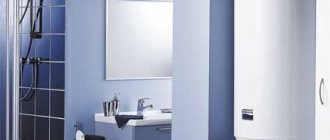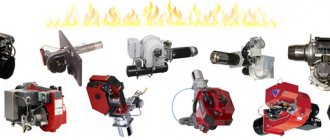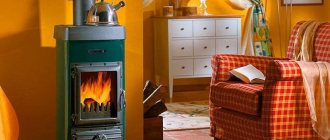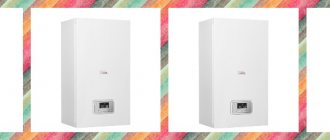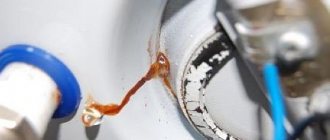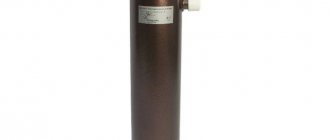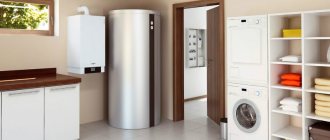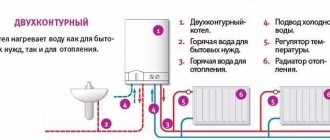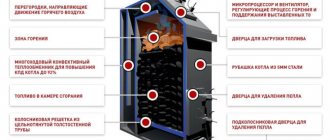No matter how planned the utilities are to turn off the heating network, this is clearly not included in our plans. Moreover, if you have the opportunity to choose a good boiler with a dry heating element. The best one: inexpensive, durable, and working properly. We tell and show you how to choose a good device and give you a selection of six top models that are in demand among buyers.
Dry heating element technology
In traditional boilers, a tubular electric heater (TEH) is installed directly in the tank for storing and heating water, in direct contact with the heating and heated medium. In water heaters with a dry heating element, it is placed in a specially designed container, sealed on one side.
Another difference is the installation of a magnetic anode to prevent scale formation and corrosion. In traditional designs, it is placed next to the heating element, and in models with dry heating, the anode is inserted through a specialized technical input.
The shape of dry heating elements also differs significantly from traditional ones. Since they are installed in a flask, they have a straightforward and compact design.
Traditional heating elements can have different configurations and even angular ones. This circumstance leads to the fact that dry heating elements are installed in boilers with a working volume above 50 liters and can be universal for use in devices of various modifications.
Design Features
Cold water entering the storage water heater through specially supplied and connected channels is heated thanks to the heating element to the previously set temperature using temperature control.
Did you know that...
A dry heating element (tubular electric heater) for water heaters is a hollow tube hidden in a ceramic flask, surrounded by an anti-corrosion layer. Inside the tube there is a wire made of a special alloy. Thanks to the electric current supplied to the rod, the heating element heats up and gives off heat to objects around it. Between the wire and the tube there is quartz sand, which has dielectric properties, increasing the electrical safety of this equipment.
This is interesting: Multicooker for baby food: how to choose, features, pros and cons
Advantages of using boilers
The main advantage of this design is that when using a dry heating element, there is no contact of the electrical part with water, and, consequently, there is no risk of electric shock to users.
If they fail, they do not function, and the electrical parts do not touch the tube, so they do not create a situation where the user is exposed to electric current.
There are quite a lot of other obvious advantages of water heaters with dry heating elements that are difficult to overestimate: the absence of scale formation on the surface of the heating element, high-speed heating and energy savings, as well as simple maintenance and a long service life.
All of the above together creates the attractiveness and popularity of this modification of water heaters on the market.
No scale
Scale on the heating surfaces of traditional heating elements occurs due to the fact that tap water contains sodium and calcium hardness salts, which increase in quantity the higher the initial hardness of natural water.
When the water comes into contact with the surface of the heating element, it has a borderline high temperature, and an intensive process of scale formation begins to occur in this layer. Scale is a poor conductor of heat, which is why the walls of the heating element begin to overheat, followed by rupture.
Dry element boilers are protected from such failures because their heating element is enclosed in a steatite bulb, which prevents direct contact with water.
Long life dry heater
Due to the use of the latest technology in water heaters with dry heating elements, their service life has been increased by an additional 5 years of continuous operation, so modifications with dry heating elements usually operate for at least 10 years. This quality allows owners to save on repairs and replacement of heating elements.
In addition, most dry heating elements have a similar structural structure and dimensions. This makes it possible to use one standard size of heating elements for different modifications of containers.
No air locks
Air lock under a thermal imager
In traditional designs of boilers with open heating elements, the formation of air locks can damage them due to violations of the cooling conditions of the walls of the structure with heated water. A boiler with a dry heating element has 100% protection against such types of accidents.
In addition, such modifications of water heaters have one important feature. If the heating element does fail, when replacing it, the user will not have to drain all the water from the working container. You just need to unscrew the safety flange, remove the heating element and replace it with a new set.
High performance
Experts have proven that traditional electric boilers take much longer to heat water in one cycle. In addition, the specific energy consumption for heating 1 liter of water in “wet” versions is much higher than with dry heating elements.
To increase the efficiency of the water heater, the steatite ceramic flask where the elements are installed is filled with oil. In this case, the thermal conductivity will be higher than usual for air modifications, which will further increase the heating rate, while significantly reducing the specific indicators for heating water, thus saving overall energy consumption.
Ease of maintenance and repair
An additional advantage of a dry heating element in an electric boiler is its ease of maintenance. The design of the device allows maintenance to be performed half as often as for a classic boiler.
Despite the fact that modern boilers are produced using the latest technologies and with high warranty periods, no manufacturer can afford to completely abandon maintenance. The user’s task to increase the overhaul period is to carry out timely maintenance of the boiler within the time limits established by the factory.
Dry start protection available
Old traditional boiler designs often fail when they are turned on without water in the tank. Water heaters with dry elements are not afraid of dry starts. This protection is guaranteed by installing a special thermal block, which does not allow the heating element to overheat in the absence of a cooling medium. The supply of electricity to the device will be stopped, so important functional elements of the boiler will not be damaged.
About methods of connecting heating elements
Let’s immediately make a reservation that heating elements for water heaters can be installed in devices either one at a time or several at a time. It is quite obvious that the more heaters, the higher the power of the boiler itself will be. But the fact is that the power indicator also depends on how the individual elements are connected - such a connection can be either single-phase or three-phase. But in city apartments, as you know, the network is single-phase, so we will consider it. So, this network provides three ways to connect the heating element:
- parallel;
- sequentially;
- combined.
Let's take a look at each of the methods mentioned.
Water heater connection diagram
Previously, we talked about how to properly connect a water heater; in addition to this article, we advise you to read this information and read about it here
Method one. Parallel connection
This connection method is carried out in accordance with the following requirements.
- The voltage both in the electrical network and in all individual elements must be the same.
- To determine the total power of an electric water heater, it is necessary to sum up the powers of all existing elements.
- If for some reason one of the heating elements fails, then the entire circuit will still function. In this case, the only thing that needs to be done is to replace the failed heating element.
Note! To determine the total power of the network, you need to divide the voltage by the total resistance of the network. And the total resistance, in turn, is determined by the traditional formula used when connecting individual resistances in parallel
Method two. Serial connection
The next method, which consists of a serial connection, operates according to the following principles.
- If one of the heating elements fails, the functioning of the entire network will be interrupted.
- In order to determine the total resistance, it will be necessary to add up all the resistances present in the network.
- Finally, the total voltage cannot in any way exceed the total voltage of all heating elements.
Note! To determine the total power of the network, you need to divide the voltage by the total resistance of the network. And the total resistance, in turn, is determined by the traditional formula used when connecting individual resistances in series
Method three. Combined connection
According to this diagram, different connection methods must be used in several sections of the circuit. Often, a combined technique is advisable in cases where it is not possible to purchase heating elements for water heaters of the required power. Therefore, the required value is achieved by combining parallel and serial connections.
Disadvantages of dry heating elements
Like all heat-heating devices, these boiler modifications have their drawbacks. The most obvious is the high price of such modifications on the market.
The discrepancy between a “wet” and a “dry” water heater usually does not exceed 2000 - 2500 rubles. However, given the long period of operation and the long turnaround time for replacing the heating element, this drawback is not significant.
Some users attribute the disadvantage of “dry” water heaters to the low power of heating elements, which is caused by their small dimensions to fit in the flask. This is true, the maximum power of such elements does not exceed 2.5 kW.
For larger tank volumes, the manufacturer eliminates this drawback by installing two heating elements, thereby not only increasing the total thermal power of the water heater, but also providing a two-variant operating mode, which also has a positive effect on increasing the service life of the equipment.
Refutation of criticism
- The assertion that this is not an economical boiler has no basis. Critics argue that the surface of the metal tube first heats up, only after a while does the liquid inside the tank warm up. But the heating process begins inside the heated medium. Therefore, heat is lost in small “doses”. In addition, the layer between the heating element itself and the inner walls of the metal tube is only a couple of millimeters.
- The mention that such a dry-type device is low-power is refuted by the numbers: a regular boiler has a power of 2000 W. One “dry” – only 1200 W. But two dry heating elements are installed in the water heater. Therefore, the total power of a dry boiler is said to be 2400 W. It’s difficult to say unequivocally that this is a minus of a dry device.
It’s hard to dispute one minus - installing a dry heating element in a boiler increases its price. For example, a 50-liter Gorenje model with a wet heater costs about 8,000 rubles. If an analogue with a dry heater is chosen, then the price will already be about 12,000 rubles. Of course, the difference of 4,000 rubles is justified by all the positive aspects of this detail.
Types of dry heating elements
The performance of such water heating devices directly depends on the quality of the protective flask. As a rule, magnesium silicate or steatite is used for the shell, and the element itself is made stainless.
A boiler with a dry heating element is a fairly new invention and is currently in the process of development. There are several basic options for their implementation:
- Oil type, when the space between the shell and the heating element is filled with oil, with high thermal conductivity.
- Quartz type is an option for filling space with quartz sand, which also has a higher thermal conductivity than air, and in this design it is easier to replace the heating element.
- The air type is the simplest option and the most affordable. Replacing the heating element will also not cause any difficulties for the user.
Principle of operation
A nichrome alloy spiral is wound onto a ceramic block and placed in a sealed flask (made of metal or ceramic). The internal space can be filled with air, quartz sand or oil.
Dry heating element device
If an ordinary heating element heats water directly (and impurities boil away and settle on it in the form of deposits), then a dry heating element heats the air and the tube in which it is located without contacting the water . By the way, the shape of a dry heater is long and thin, since it must fit into a tube, while wet models can be of any shape.
The magnesium anode is not part of the heating element, as is the case with wet options, but is inserted separately through the hole intended for it.
Nuances of choice
Choosing a water heater is a responsible process for each user, since it should last up to 10 years. It starts with determining the volume of the device.
To calculate the tank, you can contact specialists who will perform an accurate calculation of water use for hot water supply based on the volume of consumption for a specific family.
You can also use the advice and choose the following options for your household needs:
- 15-liter - enough for washing dishes, they are usually installed in the kitchen;
- 30-liter - suitable for a shower with one user;
- 50 liters, capable of providing water use via hot water supply for a family of 2 people;
- 80-liter, provides water use via hot water supply for a family of 3 people;
- 100 liters, guarantees supply for a family of 4 people.
Often for large families it is more efficient to install two devices instead of one, separately for the bathroom and kitchen.
When choosing a dry heating boiler, it is recommended to pay attention to the following parameters:
- The heating element is made of stainless steel or ceramics. Ceramic heaters cool much more slowly and do not create extraneous noise.
- The number of heating elements is better than two, since high-quality regulation is ensured and there is a power reserve in the event of failure of one of them.
- The control unit must have a thermostat, a temperature sensor, a power board and a display.
- Warranty conditions, during which the manufacturer undertakes to repair the water heater free of charge.
Comparative characteristics
Analysis of the fundamental differences between a dry heating element and a wet one allows us to characterize the heating element of the boiler even more accurately.
| Plus or minus | Dry heating element | Wet heating element |
| Lifetime | More in comparison | Less in comparison |
| Importance of maintenance once a year | Manufacturers also indicate a longer interval between cleanings. | Strictly observe the interval between cleanings |
| Service condition: 1 time per year | The tank is emptying | Water drains completely |
| Condition for replacing the heating element | Liquid remains in the tank | Liquid drains from tank |
| Water heater price | Compared to above | In comparison below |
| Impact of current | Minor | There is a threat |
| The influence of scale on the performance of heating elements | Minimum | Strong |
| The presence of 2 heating elements in the design | Common | No |
A comparative description of the two types of devices shows that the dry heating element has a preponderance of positive qualities. Water heaters with dry heating elements are more reliable in operation.
Top 5 models of boilers with dry heating elements
Ariston boiler is one of the best
Modern water heaters with a dry heating element are presented in sufficient quantities in the retail chain, starting with a capacity of 50 liters, but for the average family the best choice is a tank of 80 liters.
According to user ratings, the TOP 5 list for 2022 includes models from well-known Western and domestic brands:
- Water heater ARISTON BLU1 ECO ABS PW 65 V SLIM. The working volume of the tank is 65 l, rectangular, vertical, the internal coating is enamel, the maximum temperature is 81 C, heating is achieved by one 2.5 kW heating element in 86 minutes, electronic control. Price: RUB 8,399
- Water heater Atlantic STEATITE 80 N3. Ariston is an Italian manufacturer known far beyond Russia. The working volume of the tank of this Atlantic model is 80 liters, round, vertical, the internal coating is enamel, the maximum heating temperature of 65 C is achieved by one 2.1 kW heating element in 132 minutes, mechanical control. Price: RUB 14,499
- Water heater Gorenje TG80EBB6. The working volume of the “Combustion” tank is 76.1 l, round, vertical, the internal coating is enamel, the maximum heating temperature of 65 C is achieved by one 2.0 kW heating element in 157 minutes, mechanical control. Price: RUB 8,799
- Water heater Thermex ERD 80V. The working volume of the Thermexsmart tank is 80 liters, round, vertical, the internal coating is glass ceramics, the maximum heating temperature of 75 C is achieved by one 1.5 kW heater in 215 minutes, mechanical control. Price: 10,499 rub.
- Water heater Edison EDF 80V. The working volume of the tank is 80 l, rectangular, vertical, the internal coating is stainless steel, the maximum heating temperature of 75 C is achieved by one 1.5 kW heating element, mechanical control. Price: 15,699 rub.
All of the above models are made using modern technologies and have a high level of protection against overheating, dry start-up, water resistance class IPX3/IP24/IPX4 and anti-corrosion protection with a magnesium anode.
Which brand of storage water heater is better?
Judging by customer reviews, not all manufacturers can be trusted unreservedly. But the products of several brands that have proven themselves to be the best are in constant demand in Russia and abroad.
- STIEBEL ELTRON (Germany) manufactures climate control equipment for industrial and domestic needs. Economical storage water heaters with tanks made of stainless steel or enamel coating will serve for a long time and without failure.
- Electrolux (Sweden) also produces washing machines, dishwashers, refrigerators and other household appliances. The most popular water heaters from this company are easy to control thanks to built-in electronics. They are a little more expensive than their counterparts. But there are cheap boilers with more complex mechanical controls. Also, boilers from this manufacturer have a beautiful appearance. The bulls are made of stainless steel and some models are coated.
- Thermex (Russia) produces only water heaters. The products of this company are in demand in many countries around the world.
- Ariston (Italy) is part of the Indesit brand, producing heating boilers and water heaters and other household appliances. The boiler settings are electronic, but not fancy. The quality of the products is above average, and the prices are lower.
- Zanussi (Italy) is a subsidiary of the Electrolux concern. Produces large household appliances (refrigerators, freezers, stoves, hoods, washing and drying machines, microwave ovens). The boilers of this company have earned high customer ratings.
Water heating devices
A tubular electric heater is the main design element of boilers, which ensures heating of the water in the tank. Its operation uses a principle common to similar devices - when an electric current passes through the heating element, heat is released, which is transferred to the working environment.
Design Features
Tubular electric heaters are divided into “wet” ones, which have contact with the working environment, and “dry” ones, which do not come into contact with it.
The first version is called open and includes a steel or copper tube in its design, which is filled with a substance with high thermal conductivity. In the inner part there is a nichrome spiral, which has excellent electrical properties.
The second option is closed. It uses a special flask with special properties. It is made from magnesium silicate or steatite. In this case, heat is transferred to the working environment through this casing, which has direct contact with it.
Wet heating elements
Tubular electric heaters of this type vary, have different configurations and differ in power. Depending on the design, they provide nut or flange mounting. Boiler manufacturers can use flanges by casting or stamping.
Some models provide an anode mount. In simpler designs, an anode is not used. The type of boiler tank determines the shape of the tubular electric heater. The heating element can be straight or bent at a certain angle. The heating element material is usually steel or copper.
Dry heating elements
The design is a rod of a certain length and diameter. These are less universal devices, as they are made for a specific water heater model. They provide rapid heating of water and uninterrupted water supply as water intake increases.
Comparison of "wet" and "dry" designs
When installing flanges, contact of the tubular electric heater with the liquid is inevitable. During operation, scale and rust form on it, which leads to a decrease in the efficiency of the device and an increase in energy consumption. In addition, heat removal from the surface of the heating element is disrupted, which leads to deviations from the norm in thermal indicators. The combination of these factors causes rapid wear of the device. To increase service life, maintenance activities are carried out, which are associated with certain difficulties and require draining the water from the tank.
The flange and flask of the “dry” heating element are a single structure. Thanks to a special coating on the inside of the flange, reliable protection against corrosion is provided and deposits are not allowed to form. Oil or sand is used to fill the space between the elements of the device. The oil version provides a high rate of heating of water in the tank due to the greater thermal conductivity of oil compared to air. Due to this, energy costs are reduced. Models that use sand lighten the structure without compromising its effectiveness.
The operational safety of “wet” tubular electric heaters decreases as the layer of deposits on it increases. Scale can cause a breakdown, which creates the possibility of an electric shock. Closed models eliminate the occurrence of such a phenomenon. Ceramics or glass ceramics used to make flasks do not create conditions for the accumulation of deposits and prevent overheating of the device. This simplifies the maintenance of the heating element, since there is no need to remove water from the tank when performing this operation.
Dry type products are compact, so it is possible to install two heating elements in one boiler. This helps to increase the reliability and service life of the water heater, which is about 15 years. When using “wet” heating elements, the service life does not exceed 5 years.
What are electric heaters?
Nowadays, tubular electric heaters for heating are popular, they consist of one or several nichrome spirals in a metal shell. Periclast is placed between the spiral and the shell - this material has excellent insulating qualities.
Today there are several types of heating elements produced by manufacturers of electric heating equipment. First of all, they differ in the manufacturing method, but also have other features. Manufacturers take into account the needs and interests of consumers: some heating devices are produced in large quantities, while others are produced in small quantities. Heating equipment produced in small quantities is usually used in heating systems that have certain features. Accordingly, electric heating elements in such devices are more expensive.
Main differences
First, let's look at what a dry heating element means in a water heater. Such boiler models appeared on our market a little over 10 years ago. Since then, they have been gaining increasing popularity among owners of dachas, apartments and country houses deprived of centralized hot water supply services.
Until this time, the most common design option was a system with an immersion or “wet” heating element. This device most closely resembles an ordinary household boiler, only of enormous size. This is a hollow steel or copper tube in which a nichrome spiral is placed. The free internal space is filled with quartz sand or other similar material with high thermal conductivity. The entire structure is placed directly into the tank and comes into direct contact with the water it heats. The disadvantage of such a device is the increased formation of scale directly on the walls of the heating element, which reduces the rate of heat transfer and increases the consumption of electrical energy.
A dry heating element is designed fundamentally differently. It consists of a rheostatic wire placed in the grooves of a ceramic insulator. To avoid contact with water, the entire structure is placed in a closed flask made of metal with an anti-corrosion coating. To enhance thermal conductivity, an additional oil layer is placed between the walls of the glass and the heater.
TOP 3 best water heaters with dry heating elements Electrolux
- Electrolux EWH 50 Formax DL
- Electrolux EWH 100 Royal Flash
- Electrolux EWH 100 Centurio IQ 2.0
See also -
Which brand of water heater is better to choose?
Advantages
- The heating element hidden in the flask is not exposed to water and therefore there is no need to talk about the presence of scale on it. The part is not cleaned.
- Performance does not decrease due to an increase in scale thickness. Water has no effect at all on the heating time period specified by the designers. Heating is the same for any hardness.
- The element is easy to maintain. To replace a broken part with a new one, you will need a screwdriver. The plastic housing is removed and the spacer screw is unscrewed. Access to the part is free. To replace a wet heating element, you need to drain the liquid from the tank. The work is time-consuming and requires skills.
- Airiness of the tank is excluded. This extends its service life.
- If one of the dry heating elements burns out, then due to the fact that there are two of them built into the tank, the liquid will continue to heat up, although the heating rate will become slower. It is possible to install two dry heating elements at once due to their compactness.
- A slight tingling sensation occurs if the bulb is damaged. The force of impact is very small and does not pose any threat to health. This happens when preventative maintenance of the boiler has not been carried out for a long time. The metal flask is durable, and the heating element inside is made of ceramics (steatite). Steatite heating element prevents the occurrence of galvanic current. The service life of the tank increases.
- Boiler models with a dry boiler are not afraid of starting without water, the thermal protection will work. If this happens, the dry heating element in the water heater will take the blow and simply only it will be damaged.
- Soapstone heating elements are made from magnesium silicate, which has undergone a high-pressure pressing process. The material resists fire, withstands temperatures above 1000°C, and has a high thermal conductivity.
- By its design, a heating element made of steatite has a large heat transfer area, so the water heating process is faster.
- The device cools down more slowly than a copper heater. Due to this, electricity is saved.
- Manufacturers establish a warranty period for a boiler with a steatite heating element - 7 years, with a copper one - 3 years.
Popular manufacturers
Each boiler manufacturer produces heating elements only for its equipment
You should choose a heating element from a trusted manufacturer. This is not an element you need to skimp on. The best companies include:
- Thermex. It has been producing boilers for almost 50 years. This manufacturer produces heating elements from copper and stainless steel. They are reliably protected and therefore have a long service life. In the market, Termex has established itself as a manufacturer of boilers of the largest volume, so you can find powerful electric heaters in its assortment.
- Ariston. The heating elements from the Italian manufacturer are made of an alloy containing copper and equipped with a chromium-nickel tube. The flange is made of brass, which increases heat transfer. They are well protected from scale and easy to install. And at the same time they are relatively inexpensive. Ariston offers water heating heating elements with threads and a thermostat from 1.2 to 4.5 kW.
- Electrolux. You can choose a heating element from this manufacturer for almost any heater model. At the same time, they are guaranteed to last a long time, since they are especially resistant to scale and are not demanding on water quality. A water heater with a heating element from Electrolux does not require frequent maintenance. Some devices from this manufacturer are equipped with two closed heating elements, so it is possible to increase the heating rate of the liquid.
- Timberk. Another manufacturer that offers its products at an affordable price. The assortment includes heating elements designed for boilers with 80 or more liters of water. They are well protected from corrosion and other destructive factors.
- The company Atlantic is also known. It produces a wide range of high-quality and reliable heating elements for boilers, including copper water heating elements, dry soapstone and others, suitable for vertical and horizontal installation.
Each manufacturer produces electric heaters designed for installation in boilers of their own production. However, you can also find universal heating elements. They are less popular due to their dubious quality, but their use is possible.
Atlantic
A joint French-Ukrainian company producing this type of equipment has become quite popular due to the optimal price-quality ratio. Atlantic water heaters with a dry heater are budget models, but according to consumer reviews, they are practically not inferior to more expensive options. Many highlight such aspects as modern design, two installation methods, and affordable prices.
Atlantic STEATITE VM 80 D400-2-BC is a storage boiler that can hold 80 liters of water. Power consumption is 1500 W. There is one heating element, type – dry. Installation is only possible vertically. The body is made of stainless steel, the tank is covered with enamel. There is protection against corrosion. Currently selling for $140-150.
Atlantic VM 150 S4CM is designed for 150 hp. The maximum water temperature is 65°. It takes about 7 hours to heat up. Ten – one, dry. During the day, heat losses amount to 1.59 kW. The tank is made of metal, glass-ceramic coating with the addition of titanium dioxide. The device, not filled with water, weighs 40 kg. The cost of this model is approximately $300.
